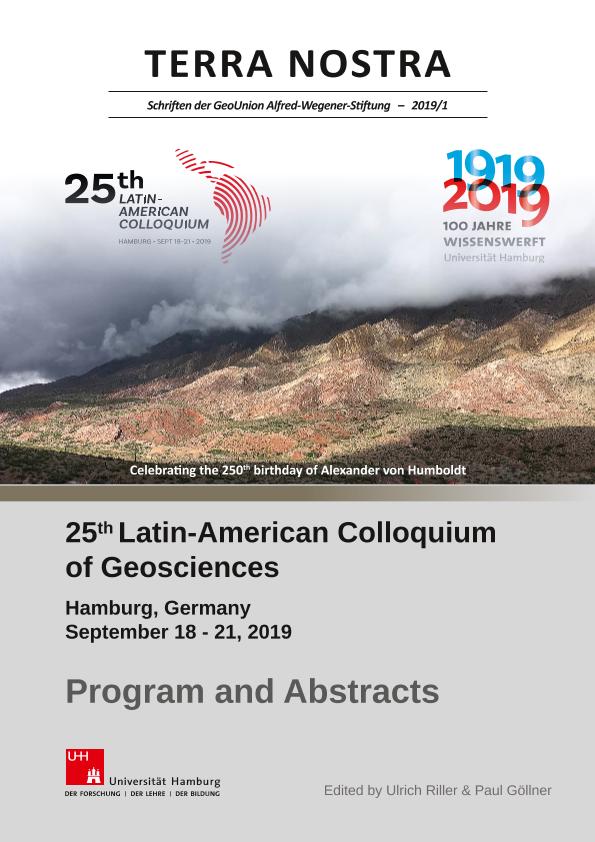Evento
Miocene volcaniclastic foreland basin infill next to the exhumed north patagonian andean batholith: a record of collapse-caldera eruptions?
López, Manuel ; Bucher, Joaquin
; Bucher, Joaquin ; García, Micaela Romina
; García, Micaela Romina ; D'Elia, Leandro
; D'Elia, Leandro ; Bilmes, Andrés
; Bilmes, Andrés ; Franzese, Juan Rafael
; Franzese, Juan Rafael
 ; Bucher, Joaquin
; Bucher, Joaquin ; García, Micaela Romina
; García, Micaela Romina ; D'Elia, Leandro
; D'Elia, Leandro ; Bilmes, Andrés
; Bilmes, Andrés ; Franzese, Juan Rafael
; Franzese, Juan Rafael
Colaboradores:
Riller, Ullrich; Göllner, Paul
Tipo del evento:
Otro
Nombre del evento:
25th Latin-American Colloquium of Geoscience
Fecha del evento:
18/09/2019
Institución Organizadora:
Universitat Hamburg;
Título del Libro:
Abstract book- Latin American Colloquium
Título de la revista:
Terra Nostra
Editorial:
Schriften GeoUnion Alfred Wegener-Stiftung
ISSN:
0946-8978
Idioma:
Inglés
Clasificación temática:
Resumen
The nature of Andean magmatism and their tectonic regimes results from variations in the angle of subduction of the Nazca and Antartic oceanic plates beneath South American plate. For the Patagonian Andes, a flat slab type subduction was proposed to the middle Miocene and the Patagonian Broken Foreland system was defined. At one time, foreland basins were filled with tens of primary and resedimented volcaniclastic materials that were distributed for more than 30.000 km2. In order to understand the relationship between tectonics and magmatic?volcanic feeder system interactions, we analysis the Miocene volcaniclastic infill succession of a basin located next to the exhumed Andean Batholith: the Collón Cura basin.The Collón Cura basin was mainly configured between 16 and 14.4 Ma due to the uplift of the north Patagonian Andes towards the west and the Sañicó Massif towards the east, evidencing the onset of the Patagonian Broken Foreland system. The uplift of the Patagonian Andes continues up to 4.8Ma. At the same time, a volcaniclastic succession of tuffs, lapilli tuffs and tuffaceous sandstones were deposited into the basin with up to 150 m-thick that reach an estimated volume of ~1800 km3. The succession is limited below by an angular unconformity and above by a regional erosional unconformity. Internally, the succession is characterized by three sections. The lower and upper sections are composed of ~50 - 70 m-thick of massive to roughly stratified and moderate-sorted vitric-rich lapilli tuff and tuffaceous sandstones. The middle section is characterized by 10 to 30 m thick of lenticular beds composed of massive, vitric-rich and moderately sorted lapilli-tuffs. Preliminary geochronological and magnetostratigraphic analysis constrain the volcaniclastic succession between 15.160 and 12.049 Ma and reveals that the whole succession has a normal polarity paleopole dated between 15.160 and 15.032 Ma, determining a maximum depositional time process of 128.000 years. Nevertheless, sedimentological features of the succession indicate that deposits were probably deposited even in a much shorter time span.During the proto- and Andean cycles, tectono-magmatic scenarios prone to collapse-caldera eruptions were recorded. In this contribution we interpret the deposition of the volcaniclastic succession as short-term processes associated with PDC´s occurred during the main structural configuration of the basin that matches with the contractional flat slab regime. The volcaniclastic succession of the Collón Cura basin would record a huge volcanic eruption deposited by catastrophic events in a many or nested collapse-caldera scenario. The origin of the calderas would be genetically associated with Miocene igneous rocks of the North Patagonian Batholith, that was exhumed in the North Patagonian Andean axis after the flat slab regime.
Palabras clave:
TECTONICS
,
PATAGONIAN BROKEN FORELAND
,
COLLON CURA
Archivos asociados
Licencia
Identificadores
Colecciones
Eventos(CIG)
Eventos de CENTRO DE INVEST.GEOLOGICAS (I)
Eventos de CENTRO DE INVEST.GEOLOGICAS (I)
Citación
Miocene volcaniclastic foreland basin infill next to the exhumed north patagonian andean batholith: a record of collapse-caldera eruptions?; 25th Latin-American Colloquium of Geoscience; Hamburgo; Alemania; 2019; 59-60
Compartir
Altmétricas



